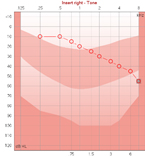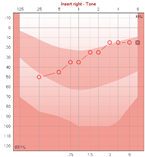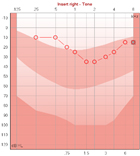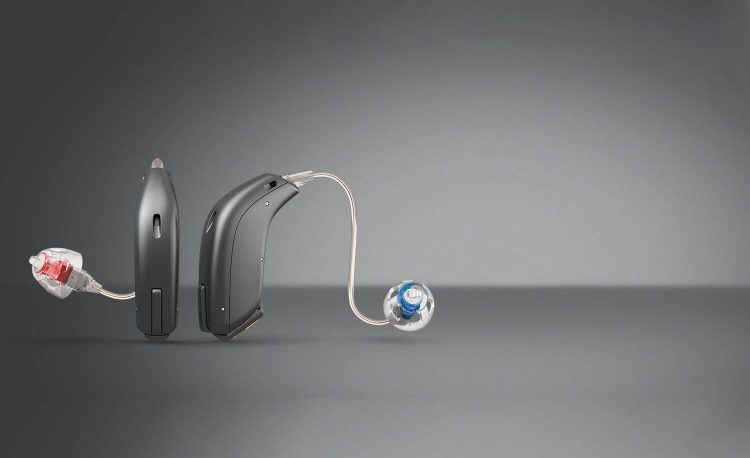The quick answer is anywhere from a couple of hundred euro to a couple of thousand euro. Why such a wide difference you may well wonder? Unfortunately, there isn’t a quick answer to this, so hopefully the following explanation provides some clarification.
Modern hearing aids nowadays are all Digital, simply put this means they are like little minicomputers. Their main purpose is to amplify sound, in practise however, this isn’t as easy as you might imagine. Typically, a person with a hearing problem does not have a straight-line loss, it can slope down, slope up, dip in the middle and to varying degrees depending on the severity of the loss.
Some examples of Hearing Loss Audiogram configurations:
| Ski Slope Loss | Reverse Ski Slope | Cookie Bite |
 |
 |
 |
This can be further compounded by the type of loss, of which there are basically three kinds:-
- Sensorineural (nerve damage to the inner ear)
- Conductive (problems with the ear canal, ear drum, or middle ear)
- Mixed (a combination of Sensorineural and Conductive)
Firstly then, a hearing aid has to configure the required amplification to match the loss as closely as possible. Secondly, and equally as important, the hearing aid needs to focus this amplification on the sounds of interest (i.e. speech) whilst not over amplifying sounds of little concern such as background noise. In hearing aid terminology this is referred to as the “Signal to Noise Ratio”, where the Signal is the good “stuff” and the Noise is the largely unwanted “stuff”.
|
|
All hearing aids are comprised of 5 basic components:
· microphone(s) · amplifier · loudspeaker · power source – battery or rechargeable · computer chip Depending on the level of technology in the hearing aid, there will be significant differences in the performance.
A basic hearing aid is fairly non-discriminatory in what it picks up and amplifies, it would suit a very undemanding listening profile e.g. one-to-one speaker with no background noise. As the technology level is stepped up, the hearing aid begins to employ its noise management system to filter out many of these unwanted sounds. The higher levels of technology also utilise advanced situational analysers to ‘sense’ the environmental situation (e.g. indoors, outdoors or in an auditorium etc) and automatically adjust their listening profile to best suit the situation. |
 Enlarged view of a CIC Enlarged view of a CIC |
Typically, in order to provide some easily understandable explanations of the different technology levels and price points, a ranking description is used to illustrate the capabilities of the various technologies employed in a hearing aid, as in the example below:-
| Tech Level | Description | Price Range |
| Premium | These aids have all the latest technology features that are available for each brand. They are optimised to give the best all round performance in all situations. | Up to €2,500 |
| Advanced | Advanced aids have many of the features of the higher end instruments. They work well in most listening environments and have programming flexibility to help meet individual needs. | Up to €2,000 |
| Performance | These devices whilst providing prescriptive amplification also have directional speech enhancement for helping in busier listening situations. | Up to €1,500 |
| Essential | Good for non-demanding listening situations and well suited for one-to-one conversations | Up to €1,000 |
| Basic | An entry level basic prescriptive amplifier | Up to €500 |
| These are just some examples of the many factors which influence the price of a modern hearing system. Much like a watch, a very basic timepiece will certainly tell you the time (the accuracy and reliability dependent on the build quality) and can start at less than a hundred euro. A more advanced watch is precision built with higher degrees of accuracy and reliability which, is reflected in the cost. |  |
The price you pay for a modern hearing system obviously firstly depends on personal affordability but secondly you must be realistic in your expectations and match your lifestyle needs to the appropriate technology level. Bear in mind that as Hearing Aids are classed as medical devices many people are entitled for help towards the purchase cost from the Government, which can be up to a maximum of €500 per aid and they can be further treated as a medical expense with a tax rebate available for a tax payer. Talk to one of our associates who can instantly check your eligibility for grant aid relief.
At The Hearing Consultancy we have access to all the main manufacturers with well over a thousand combinations of hearing devices covering all styles, technology levels and price points. We have detailed some of the available options along with costs on our website which you can find by following this link to prices. You can view some of the video demonstrations provided by various manufacturers on our Technology in Action website page.
Our Hearing Aid Audiologists will be delighted to discuss your own unique requirements with you and provide a practical demonstration of available solutions best suited to your needs and financial budget.
If you would like any further information, just give us a call on Freephone 1800 804322 or email info@thehearingconsultancy.ie.
The Hearing Consultancy – Because Hearing Matters


 Exploded view of an Oticon mini-rite
Exploded view of an Oticon mini-rite